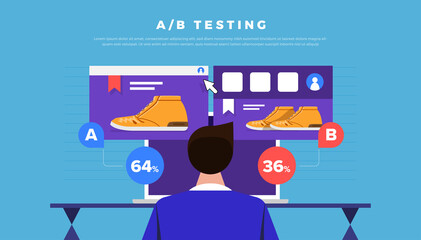We’ll increase conversions by
20-100+%
on your website.
Get a FREE Audit today
See how we can help your business increase conversion rates
Unlocking The Importance Of Micro Conversions: A Guide To Incremental Steps For Increased Sales

Introduction
In the fast-paced world of e-commerce, every step a customer or user takes while on your website is an opportunity to strengthen their connection with your brand. Micro conversions, those small yet significant actions users perform before becoming paying customers, play a vital role in nurturing leads and boosting sales.
In this blog post, we’ll explore the importance of micro conversions in crafting impactful marketing strategies and driving success for your business. Learn how these incremental steps can enhance customer engagement, improve conversion rates, and ultimately increase revenue by reading further!
Understanding Micro Conversions

Micro conversions are small, incremental steps that website visitors take to show interest in a brand, product, or service and can eventually lead to increased sales.
Why You Should Know About Micro Conversions
Micro conversions are small, yet meaningful actions taken by users on a website or online platform that pave the way for a larger, more significant conversion known as micro and macro conversions. These minor actions can include activities like signing up for newsletters, downloading e-books, adding items to wish lists, or engaging with interactive content. Such seemingly insignificant steps provide businesses with valuable insights into customer behavior, preferences and their overall journey through the sales funnel.
Paying attention to tracking micro conversions is crucial in optimizing user experience and maximizing conversion rates from potential customers to paying clients. Monitoring these incremental steps allows businesses to gain a better understanding of visitor behavior patterns within their websites and fine-tune specific elements accordingly – be it design components, marketing messages or call-to-action buttons. Furthermore, tracking micro conversions helps identify areas where friction points might exist within the purchasing process so that necessary improvements can be made promptly. By focusing on these smaller milestones in the buyer’s journey, businesses are better equipped to make data-driven decisions leading to increased sales and enhanced customer retention rates over time.
Examples Of Micro Conversions
Micro conversions are small, incremental steps that users take while engaging with a brand’s products or services, ultimately leading them closer to a macro conversion. A few examples of why micro conversions are important include:
1. Signing up for an email newsletter.
2. Creating an account on the website.
3. Adding a product to the shopping cart or wish list.
4. Sharing content on social media platforms.
5. Downloading a free trial or product demo.
6. Watching a video about the product or service.
7. Reading and engaging with blog posts and articles.
8. Participating in surveys, quizzes, or polls on other pages viewed the site.
9. Clicking on call-to-action (CTA) buttons like “Learn More” or “Request Demo.”
10. Browsing multiple pages of pricing page of the website and spending time reading product descriptions.
By tracking and optimizing these micro conversions, businesses can improve their overall customer journey and create more opportunities for successful macro conversions like completing a sale, subscribing to a service, or signing up as a new user.
Benefits Of Focusing On Micro Conversions

Focusing on micro conversions can lead to improved customer engagement, higher conversion rates, and enhanced customer retention – learn how to make the most of these benefits in your own business!
Improved Customer Engagement
Focusing on micro conversions can have a significant impact on customer engagement. By identifying opportunities for customers to take small, desirable actions throughout their journey on a website, businesses create more touchpoints for engagement. For example, offering a free trial or creating a wish list feature encourages users to interact with the site beyond just browsing products or services. These micro interactions show customers that the company values their experience and is invested in helping them find what they need.
Improved customer engagement leads to higher conversion rates and increased sales. When customers feel valued and engaged, they are more likely to return for future purchases or recommend the business to others. By optimizing the user experience around these smaller interactions, businesses build trust with potential buyers and increase loyalty from current ones. Ultimately, focusing on micro conversions creates a positive feedback loop of improved engagement leading to increased sales that benefits both the customer and the business alike.
Higher Conversion Rates
One of the major benefits of focusing on micro conversion optimization is higher conversion rates. By optimizing these small steps, visitors are more likely to take the primary desired action on a website, resulting in increased sales. For example, improving the user experience during the checkout process ecommerce website by simplifying it and offering various payment options can lead to a higher conversion rate.
Furthermore, personalizing communications with potential customers through email marketing or retargeting ads based on their past behavior and interests can also result in higher conversion rates. By tailoring messages that resonate with each individual, they are more likely to feel seen and understood which can increase their trust in your brand leading them further down the buyer’s journey.
Overall, when businesses focus on maximizing micro goals and conversions as well as macro goals it leads to solid leads and increased sales possibilities enhancing end-to-end customer experiences making sure that users click convert into paying customers.
Enhanced Customer Retention
Focusing on micro conversions can lead to enhanced customer retention, which means more customers are staying and returning for future purchases. By optimizing the user experience and personalizing communication through analyzing user behavior, businesses can build stronger relationships with their customers. For example, offering product recommendations based on a customer’s previous purchases or wishlist items can increase engagement and encourage repeat sales.
In addition, using social proof such as reviews or testimonials from satisfied customers can also enhance customer trust and loyalty. Simplifying the checkout process is another effective way to improve retention rates by reducing friction points that may discourage potential customers from completing their purchase. By prioritizing micro conversions that ultimately lead to increased sales, businesses can create a positive cycle of keeping users engaged throughout their buying journey.
Overall, it’s crucial for business owners to understand the importance of micro conversions in achieving higher conversion rates and improving customer retention. These incremental steps towards making small changes in user behavior and building strong relationships with customers can have significant impacts on overall success.
Strategies For Identifying And Optimizing Micro Conversions

Learn how to analyze user behavior, optimize user experience, personalize communications, implement social proof and use call-to-actions (CTAs) to identify and optimize the importance of macro and micro conversions for increased sales. Discover the power of these strategies in nurturing leads and transforming them into paying customers.
Analyzing User Behavior
To effectively track and measure micro conversions and identify and optimize micro conversions, it is crucial to study user behavior. Analyzing user behavior involves tracking actions taken by visitors on your website and understanding their motivations for those actions. This data can be gathered through tools such as Google Analytics, heat maps, and surveys.
By analyzing user behavior, you can pinpoint what’s preventing users from converting on the primary goal of your site. For example, if visitors are abandoning their shopping carts before completing a purchase, it may indicate issues with the checkout process or unexpected fees at the final stage. Once you’ve identified these friction points in the buyer journey, you can work towards improving UX improvements that simplify the conversion process or offer incentives like free shipping to encourage more sales.
Additionally, studying micro conversions enables businesses to track potential future macro conversions that signify a solid lead or paying customer. By track macro conversions by creating milestones within each step of the buyer journey (such as signing up for a free trial or adding items to wish lists), companies have greater insight into which secondary actions directly lead to a primary primary macro conversion goal – resulting in happier customers and increased sales overall.
Optimizing User Experience
Optimizing the user experience (UX) is crucial to improving micro conversions and achieving primary conversion rate optimization goals. This involves creating a seamless website flow that guides users towards desirable actions. Removing friction points in the buyer’s journey, such as simplifying the checkout process or reducing page load times, can significantly increase micro conversion rates.
Personalization tactics are also an essential part of optimizing UX for both micro and macro-conversions. For example, customizing product recommendations based on user behavior or purchase history can lead to higher click-through and conversion rates. Furthermore, utilizing social proof through customer reviews or endorsements can improve trust and credibility with potential customers, leading to more successful micro conversions.
Studying visitor behavior using tools like Google Analytics helps identify areas for improvement in UX design. Examining where users drop off or spend more time on specific pages informs opportunities for optimization measures that lead to increased sales and overall conversions.
Personalizing Communications
Personalizing communications can be a powerful way to improve micro conversions. By tailoring messages and content to individual users’ preferences, interests, and behaviors, you can increase engagement and boost conversions. For example, using email marketing tools that allow you to segment your audience based on their purchase history or browsing activity can help you send more targeted and relevant messages.
Another effective strategy is using dynamic content on your website or landing pages that changes based on the user’s behavior or profile data. This could include showing personalized product recommendations, displaying different messaging for first-time visitors versus returning customers, or highlighting promotions relevant to specific demographics. By personalizing these interactions with potential buyers, you’re more likely to capture their attention and drive them towards making a purchase.
Overall, personalization helps create a deeper connection between the user and your brand which results in higher conversion rates over time. By taking advantage of available data such as browsing patterns or purchasing history in order tailor messaging precisely for each visitor will work wonders for increased sales growth through micro conversions!
Implementing Social Proof
A great way to identify and optimize micro conversions is by implementing social proof. Social proof works on the principle that if other people are doing it or using it, then it must be good. By showcasing positive reviews, testimonials, and user-generated content on your website, you can establish trust with potential customers and encourage them to take desirable actions such as more sign up form top-ups, purchases or free trial enrollments.
For example, a SaaS company could use customer reviews prominently displayed on their homepage to build credibility for their software product. The reviews could be accompanied by star ratings and user photos for added authenticity. This kind of social proof creates a sense of community around the brand which motivates users to signup for a free trial or buy the product.
It’s important to note that while social proof is an effective strategy for optimizing micro conversions, it should also be used alongside other micro conversion examples of optimization and techniques such as A/B testing and personalization efforts which help improve conversion rates even further in eCommerce websites or online businesses.
Using Call-to-Actions (CTAs)
One of the most effective strategies for identifying and optimizing micro conversions is to use call-to-actions (CTAs). These are prompts that encourage visitors to take specific actions that move them closer towards a larger macro conversion. CTAs can be used on various pages, including product pages, pricing pages, and even blog posts. For example, a CTA could prompt users to sign up for a free trial or join your monthly newsletter.
Implementing CTAs helps create momentum in the buyer journey by guiding visitors towards the next desirable action. By using strong language and design elements that command attention, they increase the likelihood of users clicking through and completing micro-conversions such as filling out forms or adding products to their wish list. Without these CTAs in place, website visitors may lose interest or feel unsure about what action they should take next.
By strategically placing well-designed calls-to-action throughout your website or marketing materials, you can unlock hidden conversions by driving more traffic towards primary goals. This approach offers a powerful way to convert new leads into solid customers by breaking down sales into smaller steps that are easier for prospects to navigate without becoming overwhelmed.
How To Harness The Power Of Micro Conversions For Increased Sales

Learn about the effective strategies for leveraging micro conversions, such as A/B testing and simplifying checkout processes, to boost sales and customer retention. Don’t miss out on this important guide to incremental steps towards increased revenue!
A/B Testing And Experimentation
A/B testing and experimentation track micro conversions are essential steps in harnessing the power of micro conversions for increased sales. Here’s how you can conduct successful A/B tests track micro conversions and analyze results:
1. Define your goals: Before conducting an A/B test, you must have a clear idea of what you want to achieve. Identify the desired outcome for each experiment and set specific and measurable goals.
2. Create two versions: Create two versions of your webpage or email campaign – one with your existing layout, content, and design (control), and the other with a new variation that includes changes in messaging, images, or layout (test).
3. Track user behavior: Use a Google Analytics account to track user behavior on both the control and test pages. Analyze metrics such as bounce rates, time on site, clicks, conversions, and revenue.
4. Conduct statistical analysis: Use statistical methods to analyze test results accurately. Calculate sample size requirements, perform hypothesis testing, and determine the confidence level for results.
5. Take action: Based on the results of your A/B test, implement changes that have a positive impact on conversion rates.
6. Repeat the process: Keep conducting A/B tests regularly to continuously improve your website or email campaigns’ performance.
By following these steps, you can drive real lift in sales and conversion rates through A/B testing and experimentation. Plus, consider using automation or AI tools to scale up your testing efforts for even bigger picture more significant impacts.
Upselling And Cross-Selling
Cross-selling and upselling are two essential techniques that can be utilized to increase revenue from existing customers. These tactics involve offering related products or services to the customer at the point of sale. Here are some strategies for effective cross-selling and upselling:
1. Understand your customers’ needs: Before attempting any cross-selling or upselling, it is crucial to have a clear understanding of your customers’ needs and preferences. This can be achieved through analyzing customer data and getting feedback from them.
2. Offer relevant products or services: The products or services offered should be relevant to the potential customer’s previous purchase or current interests. This enhances the likelihood of acceptance and subsequent satisfaction by potential customer.
3. Use persuasive language: The language used when presenting the additional product should focus on the benefits that the customer will get from it rather than just its features.
4. Bundle offers: Offering bundled packages can increase sales since they provide value for both parties involved.
5. Personalization: Personalizing recommendations based on past behavior or demonstrated interests is an effective way of increasing acceptance rates.
Cross-selling and upselling are powerful ways of driving revenue for businesses while enhancing customer satisfaction by providing tailored solutions to their needs.
Improving Product Recommendations
One of the key strategies for harnessing the power of micro conversions is improving product recommendations. By providing relevant and personalized product recommendations to customers, businesses can increase the likelihood of conversion and improve customer satisfaction. This can be achieved through various tactics such as analyzing user behavior, implementing social proof, and using machine learning algorithms to suggest products based on past purchases or browsing history.
For example, Amazon has been able to leverage its vast amount of user data to provide highly personalized product recommendations that drive a significant portion of its sales. Similarly, Netflix uses sophisticated algorithms to recommend TV shows and movies based on users’ viewing habits. By focusing on improving product recommendations as a micro and conversion rate optimization strategy, businesses can create a more streamlined buying experience for their customers while increasing sales in incremental steps.
In addition, simplifying the checkout process by reducing friction points such as lengthy forms or mandatory account creation is another way to improve product recommendations as part of micro conversions. By designing a smooth checkout flow with fewer obstacles between adding items to cart and checking out, businesses can help improve overall conversions while also ensuring that customers have access to personalized product suggestions at every stage along their buyer journey.
Simplifying Checkout Process
One of the most crucial steps in increasing sales is by simplifying the checkout process. A complicated and lengthy checkout process can lead to cart abandonment, which ultimately reduces conversions. To simplify the checkout process, consider removing any unnecessary fields or steps on your checkout page. Ensure that your customers have an intuitive and straightforward experience when making their final purchase.
Another way to simplify the checkout process is by using a progress bar on your page. This allows users to know how many steps are left before they complete their purchase, easing any concerns about how long it will take them to finish. Additionally, consider offering multiple payment options, such as PayPal or Apple Pay, to allow for easy and quick completion of transactions.
According to Mediaworks Digital Masterclass, simplifying the checkout process leads to reduced friction points and a higher conversion rate. As much as possible, make it easy for visitors to buy from you promptly by eliminating distractions or pop-ups during this critical part of their buyer’s journey.
Conclusion

In today’s competitive online marketplace, it’s crucial to understand the importance of micro conversions. These small steps a customer takes towards conversion can ultimately lead to significant increases in sales and revenue for your business.
By focusing on optimizing each micro conversion through strategies such as analyzing user behavior, personalizing communications, and simplifying the checkout process, you can improve customer engagement and retention. Don’t overlook the value of these incremental steps – they are essential for nurturing leads and establishing trust with potential customers. So start tracking those micro conversions today to unlock their power and take your sales to new heights!








